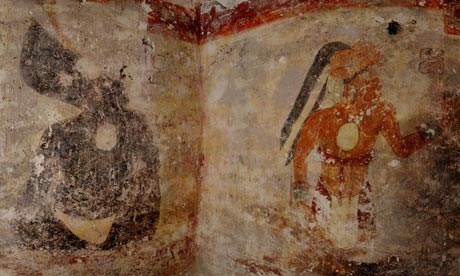
One wall of the Mayan house is adorned with paintings of men wearing mitres, white loin cloths and medallions. Photograph: Tyrone Turner/National Geographic
Ancient inscriptions on the walls of a looted house in the Guatemalan jungle are the oldest astronomical charts known from the Mayan civilisation.
Explorers chanced upon the writings while excavating a room buried under a collapsed building that was overgrown with rainforest vegetation in Xultún in the north-eastern region of Petén.
Researchers who dug debris from the room found bright and vivid paintings of the king and other figures preserved on the walls, leading them to speculate the owner might have been a royal relative.
One wall was covered with hundreds of small red and black symbols that tracked the phases of the moon, with others thought to represent the Mayan ceremonial calendar and cycles of the sun, Mars and Venus.
The hieroglyphs date to about AD814, making them considerably older than the Dresden codex, an 11th- or 12th-century Mayan book written on bark paper, which found its way to the Royal Library at Dresden in 1739. The Mayans kept detailed records of the heavens and tied traditional ceremonies to these celestial events.
"There are tiny glyphs all over the wall, bars and dots representing columns of numbers," said David Stuart, a professor of Mesoamerican art at the University of Texas at Austin, who deciphered the symbols. "It's the kind of thing that only appears in one place, the Dresden codex, which the Maya wrote many centuries later. We've never seen anything like it."
William Saturno, an archaeologist at Boston University who led the exploration and excavation, said some calculations predicted astronomical events 7,000 years into the future. Contrary to some theories, there was no sign that the Mayan calendar ended abruptly in 2012.
Archaeologists took an interest in the building, which lies among thousands of others, after Max Chamberlain, a student of Saturno, followed a looter's trench to the site in 2010. Looters have targeted Mayan temples throughout history, using tree saws to cut up and remove large wooden monuments in the 1970s, and more recently taking vases, figurines and jade to sell on the art market.
The building Chamberlain found sat over a room that had been loosely filled with soil and stone. When Chamberlain looked inside, he noticed two red marks on an exposed wall of the room, but it took several hours of excavation to reveal hints of the lavish artwork and calendars beneath.
Writing in the journal, Science, Saturno describes how he returned to the site in 2011 with a grant from National Geographic to excavate the room completely. The east wall was dominated with columns of numbers, represented by dots, bars and shell-like inscriptions, some of which tracked the moon or reconciled lunar phases with the solar calendar. Other tables of red numbers appear to be numerical corrections to make calculations more accurate.
"This is certainly our oldest Mayan astronomical table. It's the only one we have from the classical period. It's also the first time we get to look inside a scribe or astronomer's house and see the writing on the wall," Saturno told the Guardian. More enigmatic charts on the north wall appear to represent the 365-day solar calendar, the 584-day cycle of Venus and the 780-day cycle of Mars.
"They were keen on keeping track of all planetary motions. They liked to anchor the events of their lives in cosmic terms. What comes around today will repeat again in the future and is a symbol of what happened in the distant past," Saturno added.
Anthony Aveni, a co-author on the study at Colgate University in New York, said: "The most exciting point is that we now see that the Mayan were making such computations hundreds of years – and in places other than books – before they recorded them in the codices."
The excavation ultimately revealed figures on all four walls of the room. On the north wall, Saturno uncovered a portrait of the king, seated and wearing blue feathers, facing a figure in vibrant orange holding a stylus. Markings near the latter figure's face call him "Younger brother Obsidian", who could be the younger sibling or son of the king, and the scribe who lived in the house.
Around the image were fixtures for a curtain that allowed the painting to be covered up or exposed. The west wall was adorned with paintings of three men wearing large, feathered black mitres, white loin cloths and medallions around their necks.

No comments:
Post a Comment